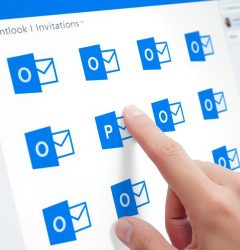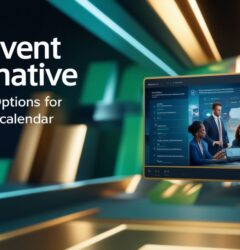- Email: [email protected]
- phone: +44 (0) 203 916 5117
03 Jun

In a world dominated by hybrid workplaces, back-to-back virtual meetings, and high-stakes conferences and personalized calendar invites, scheduling is no longer a passive task. It has evolved into a strategic function that can make or break an event. For marketing teams, CXOs, webinar operations, and delegate outreach teams, sending thousands of calendar invites for webinars, meetings, and conferences is not just about efficiency. It's about relevance, personalization, and precision.
Traditional methods such as manual invites or BCC emails don’t scale well when you need to send mass meeting invites or manage personalized RSVPs. And while Google Calendar, Outlook, or Office 365 work well for everyday use, they fall short when you need to send mass meeting invites in Outlook or create highly personalized invitations across thousands of participants.
That's where platforms like Let’s Calendar step in, redefining what bulk scheduling can look like—at scale, discreetly, and tailored to every recipient.
The Scheduling Challenge—Why Organizers Need Bulk Solutions
Whether you’re organizing a 500-attendee webinar or sending out monthly product demos to prospects, scheduling becomes a bottleneck when you're doing it manually. Here are some of the most common challenges event teams face:
- Limited support for bulk calendar invites in mainstream tools.
- Risk of leaking recipient lists when sending group invites.
- No option for 1:1 personalization based on geography, role, or timezone.
- Ineffective RSVP tracking with basic invite tools.
Even advanced users trying to send bulk meeting invites in Gmail or use bulk meeting invites in O365 face issues around personalization and deliverability. Email clients often flag bulk calendar links as spam or send them to clutter folders.
This makes the case for a smarter, purpose-built solution: bulk calendar scheduling that feels personal and arrives in the primary inbox.
What Makes an Invite Truly Personalized?
A personalized calendar invite is more than just including the recipient's name. It’s about:
- Choosing the right meeting time based on timezone.
- Embedding platform-specific links (e.g., Zoom or Google Meet).
- Sharing role-specific agendas.
- Including reminders and follow-ups specific to that event.
For example, a CXO-level client might get a Zoom invite with a high-level strategy doc, while a sales rep might receive a product deep-dive session. With Let’s Calendar, each of these experiences can be scheduled and delivered automatically—at scale.
The platform supports add to event and add calendar to event integrations, ensuring your calendar invite integrates seamlessly across platforms.
Introducing Let’s Calendar—Discreet, Scalable, and Integrated
Let’s Calendar is not just another scheduling app. It's a bulk scheduling powerhouse tailored for high-volume, high-stakes meetings.
Key features include:
- Browser-based experience: No downloads or plug-ins required.
- 1:1 invitation sending: Every invitee receives a unique, secure invite.
- CSV/CRM integration: Upload 10 or 10,000 contacts with personalized data.
- Calendar agnostic: Syncs with Gmail, Outlook, Google Calendar, and Apple Calendar.
- Zoom/Webinar integrations: Automatically include Zoom links with personalized metadata.
Let’s Calendar allows you to effortlessly schedule mass calendar invites in Gmail or send mass calendar invites in Google with personalized content for each user—without using mass-email tools.
You can also send mass calendar invite in Gmail or configure mass calendar invites in O365 with timezone-aware links, titles, and descriptions. These details are embedded in a structured .ics file to ensure high deliverability.
Cross-Platform Integration—How to Add Events to Any Calendar
One of the standout features of Let’s Calendar is its seamless compatibility across platforms. You can easily create:
- addevent buttons embedded into emails.
- One-click add calendar links for any major calendar tool.
- Event-specific .ics files for download.
How to use it:
- Create a master event in Let’s Calendar.
- Upload your invitee list with custom fields.
- Set personalized meeting info per user.
- Generate universal calendar links or individual .ics files.
- Distribute via email, SMS, WhatsApp, or web embed.
This method supports add calendar to event and addevent integrations while keeping tracking intact.
Real-Time Tracking and Feedback Loop
One of the most overlooked aspects of scheduling is tracking. Who received your invite? Who opened it? Who added it to their calendar? Who attended the meeting?
With Let’s Calendar, you get:
- RSVP dashboards with real-time data.
- Attendance and engagement metrics.
- Automated reminders and rescheduling workflows.
Whether you're managing bulk meeting invites for internal teams or sending send mass calendar invites to potential clients, having this loop is critical for optimizing engagement.
Use Cases: From Webinars to CXO Dinners
Let’s Calendar isn’t just for one type of event. It’s built for every kind of meeting you might imagine.
- Webinars: Send thousands of invites with unique access links and reminder workflows.
- Sales Demos: Customize calendar content for different customer segments.
- Investor Meetings: Schedule recurring events with strict privacy controls.
- CXO Roundtables: Deliver personalized .ics files that feel like hand-written invitations.
Whether you’re handling mass calendar invite projects or need to send bulk meeting invites in Gmail to different regions, Let’s Calendar gives you the scale and personalization you need.
Conclusion: The Future Is Personalized and Scalable
The future of calendar scheduling is not in one-size-fits-all tools, but in platforms that understand the value of personalization, discretion, and scale.
Tools like Gmail, Outlook, or even CRM-integrated scheduling platforms can manage day-to-day logistics, but when it comes to bulk calendar invite campaigns, only purpose-built tools like Let’s Calendar can deliver.
From mass calendar invites in O365 to handling CXO roundtables with precision, Let’s Calendar is built for the new era of event scheduling.
Explore more at www.letscalendar.com









Recent Comments